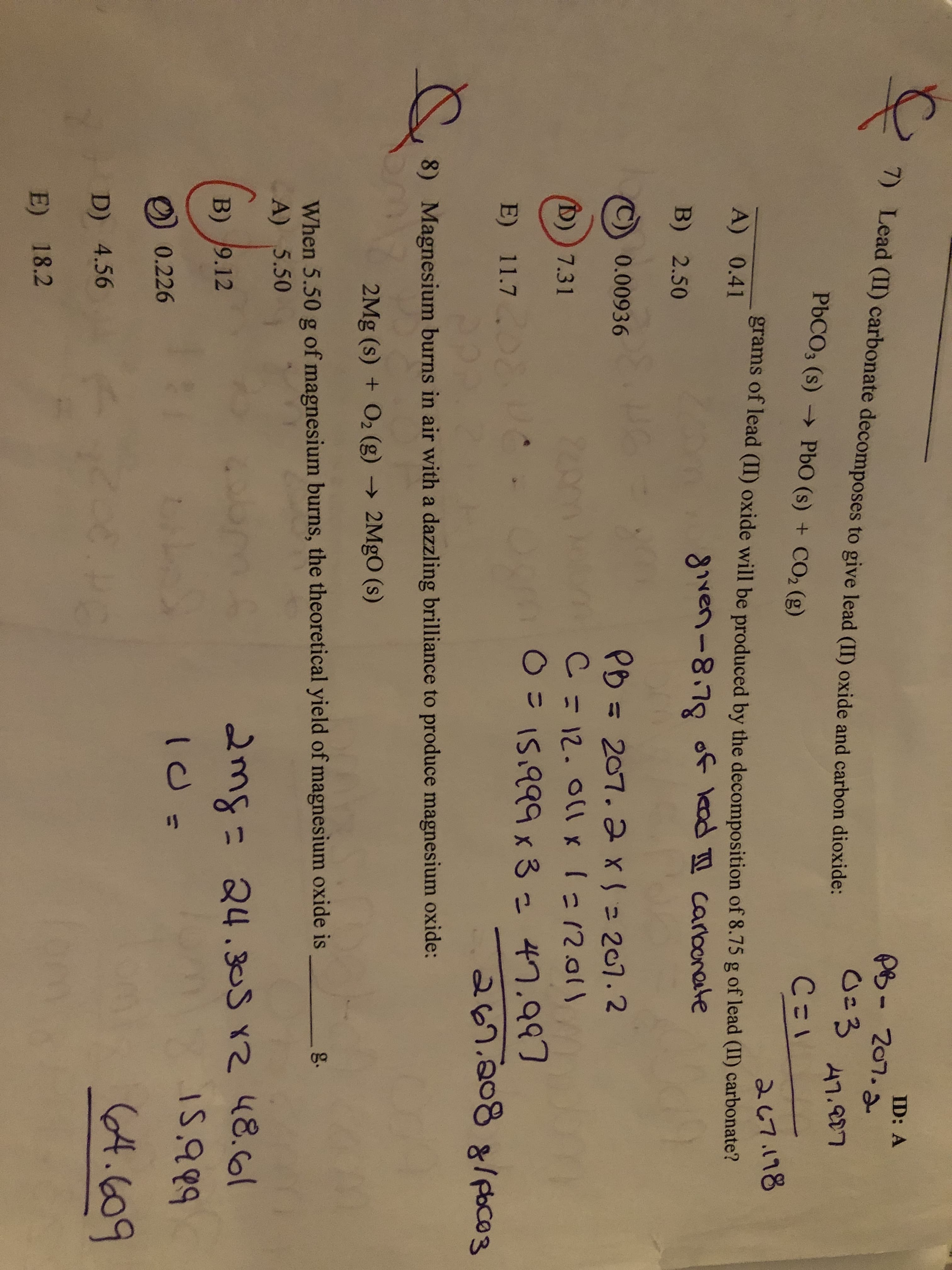1) Lead (II) carbonate decomposes to give lead (II) oxide and carbon dioxide: P凸-207.ふ 0=3 ID: A PBCO3 (s) → PbO (s) + CO2 (g) 47.807 C=1 267.178 grams of lead (II) oxide will be produced by the decomposition of 8.75 g of lead (II) carbonate? A) 0.41 given-8.78 of kad carbonete B) 2.50 0.00936 PB = 207. 2x= 207.2 C = 12. O1x 1=12.01 %3D D)) 7.31 O= I5.999x 3= 47.997 E) 11.7 267.2088/ poco3 8) Magnesium burns in air with a dazzling brilliance to produce magnesium oxide: 2Mg (s) + O2 (g) → 2MGO (s) When 5.50 g of magnesium burns, the theoretical yield of magnesium oxide is A) 5.50 g. 24.305 x2 48.61 I5.99 B) 9.12 2mg= 0.226 (4.609 D) 4.56 E) 18.2
1) Lead (II) carbonate decomposes to give lead (II) oxide and carbon dioxide: P凸-207.ふ 0=3 ID: A PBCO3 (s) → PbO (s) + CO2 (g) 47.807 C=1 267.178 grams of lead (II) oxide will be produced by the decomposition of 8.75 g of lead (II) carbonate? A) 0.41 given-8.78 of kad carbonete B) 2.50 0.00936 PB = 207. 2x= 207.2 C = 12. O1x 1=12.01 %3D D)) 7.31 O= I5.999x 3= 47.997 E) 11.7 267.2088/ poco3 8) Magnesium burns in air with a dazzling brilliance to produce magnesium oxide: 2Mg (s) + O2 (g) → 2MGO (s) When 5.50 g of magnesium burns, the theoretical yield of magnesium oxide is A) 5.50 g. 24.305 x2 48.61 I5.99 B) 9.12 2mg= 0.226 (4.609 D) 4.56 E) 18.2
Chemistry & Chemical Reactivity
10th Edition
ISBN:9781337399074
Author:John C. Kotz, Paul M. Treichel, John Townsend, David Treichel
Publisher:John C. Kotz, Paul M. Treichel, John Townsend, David Treichel
Chapter4: Stoichiometry: Quantitative Information About Chemical Reactions
Section: Chapter Questions
Problem 24PS: Methanol, CH3OH, can be prepared from carbon monoxide and hydrogen. CO(g) + 2 H2(g) CH3OH(l) What...
Related questions
Question
Question 7

Transcribed Image Text:1) Lead (II) carbonate decomposes to give lead (II) oxide and carbon dioxide:
P凸-207.ふ
0=3
ID: A
PBCO3 (s) → PbO (s) + CO2 (g)
47.807
C=1
267.178
grams of lead (II) oxide will be produced by the decomposition of 8.75 g of lead (II) carbonate?
A) 0.41
given-8.78 of kad carbonete
B) 2.50
0.00936
PB = 207. 2x= 207.2
C = 12. O1x 1=12.01
%3D
D)) 7.31
O= I5.999x 3= 47.997
E) 11.7
267.2088/ poco3
8)
Magnesium burns in air with a dazzling brilliance to produce magnesium oxide:
2Mg (s) + O2 (g) → 2MGO (s)
When 5.50 g of magnesium burns, the theoretical yield of magnesium oxide is
A) 5.50
g.
24.305 x2 48.61
I5.99
B) 9.12
2mg=
0.226
(4.609
D) 4.56
E) 18.2
Expert Solution
This question has been solved!
Explore an expertly crafted, step-by-step solution for a thorough understanding of key concepts.
This is a popular solution!
Trending now
This is a popular solution!
Step by step
Solved in 3 steps with 2 images

Knowledge Booster
Learn more about
Need a deep-dive on the concept behind this application? Look no further. Learn more about this topic, chemistry and related others by exploring similar questions and additional content below.Recommended textbooks for you

Chemistry & Chemical Reactivity
Chemistry
ISBN:
9781337399074
Author:
John C. Kotz, Paul M. Treichel, John Townsend, David Treichel
Publisher:
Cengage Learning

Chemistry & Chemical Reactivity
Chemistry
ISBN:
9781133949640
Author:
John C. Kotz, Paul M. Treichel, John Townsend, David Treichel
Publisher:
Cengage Learning

Chemistry for Engineering Students
Chemistry
ISBN:
9781337398909
Author:
Lawrence S. Brown, Tom Holme
Publisher:
Cengage Learning

Chemistry & Chemical Reactivity
Chemistry
ISBN:
9781337399074
Author:
John C. Kotz, Paul M. Treichel, John Townsend, David Treichel
Publisher:
Cengage Learning

Chemistry & Chemical Reactivity
Chemistry
ISBN:
9781133949640
Author:
John C. Kotz, Paul M. Treichel, John Townsend, David Treichel
Publisher:
Cengage Learning

Chemistry for Engineering Students
Chemistry
ISBN:
9781337398909
Author:
Lawrence S. Brown, Tom Holme
Publisher:
Cengage Learning

Chemistry: An Atoms First Approach
Chemistry
ISBN:
9781305079243
Author:
Steven S. Zumdahl, Susan A. Zumdahl
Publisher:
Cengage Learning


General Chemistry - Standalone book (MindTap Cour…
Chemistry
ISBN:
9781305580343
Author:
Steven D. Gammon, Ebbing, Darrell Ebbing, Steven D., Darrell; Gammon, Darrell Ebbing; Steven D. Gammon, Darrell D.; Gammon, Ebbing; Steven D. Gammon; Darrell
Publisher:
Cengage Learning